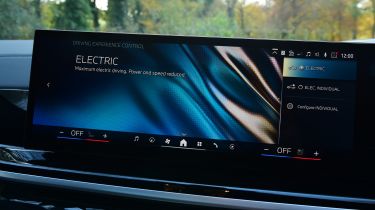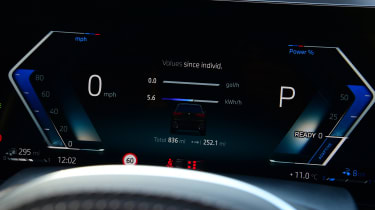BMW X5 - MPG, CO2 and running costs
Fuel efficiency for the BMW X5 is good for a hefty SUV, but other running costs won’t be cheap

If you want to minimise running costs, go for the plug-in hybrid xDrive50e. It has a 3.0-litre six-cylinder petrol engine and electric motor powered by a lithium-ion battery with a 25.7kWh usable capacity. The impressive all-electric range of up to 65 miles helps deliver an official fuel consumption figure of 313.9mpg under WLTP testing. You’d need to regularly charge the battery to get anywhere near that figure, though. On a long 450-mile drive, our average on both petrol and electricity was 43.5mpg.
Emissions of 20g/km make the xDrive50e an ideal choice for company car drivers, who stand to make serious savings on their monthly company car tax bills. However, the plug-in hybrid Range Rover Sport P460e has an even larger battery pack and can travel farther on a charge, meaning it sits in an even lower Benefit-in-Kind (BiK) tax bracket.
While the xDrive50e doesn’t have rapid charge capability like the plug-in hybrid Range Rover Sport, the charging speed has been increased from the rather slow 3kW of earlier cars, up to 7.4kW. That decreases recharge times from nine hours, down to four and a half when using a suitably quick wallbox charger.
The xDrive30d will return an average consumption of 39.8mpg, the same as a 300d Mercedes GLE and a little better than a D300 Range Rover Sport. The diesel X5’s 179g/km emissions put it into the top 37 per cent Benefit-in-Kind (BiK) tax bracket, so it’s not cheap from a company car perspective. The other diesel option is the 335bhp xDrive40d, which offers greater performance yet still returns 37.7mpg and 196g/km of CO2.
More reviews
Car group tests
- Porsche Cayenne vs BMW X5 2024 twin test: sporty plug-in hybrids battle for supremacy
- BMW X5 vs Porsche Cayenne vs Jaguar I-Pace
In-depth reviews
Long-term tests
Road tests
- New BMW X5 xDrive50e review: plug-in hybrid power enhances an already solid SUV package
- New BMW iX5 Hydrogen 2023 review
- New BMW X5 M Competition 2021 review
Used car tests
The petrol-engined M60i is strictly for those with deep pockets, as the 4.4-litre V8 only manages 24.4mpg with CO2 emissions of 263g/km. In comparison, the M Competition model is even less efficient, with fuel economy of 21.1mpg and producing 304g/km of CO2.
Insurance groups
As expected of a powerful, premium SUV, insurance groups start at group 45 for the xDrive30d. The rest of the lineup rises to 47 for the xDrive40d, 49 for the xDrive50e, all the way up to group 50 for the M60i and X5 M Competition.
Those are on par with the equivalent Mercedes GLE and Range Rover Sport. However, the Audi Q7 starts from group 42, making it cheaper to insure.
You can get personalised car insurance quotes fast with our comparison tool powered by Quotezone...
Depreciation
The undoubted cachet of the BMW badge, the novelty value of the latest-generation X5 and the appeal of its style and technology should mean residual values remain strong. Our expert data suggests that the X5 should hold onto between 40-59 per cent of its original value after three years and 36,000 miles of motoring, with M Sport models generally performing best. The X5 that’ll hold onto its resale value the best will be the xDrive50e M Sport with the technology pack.
A Q7 and GLE will lose significantly more value than the equivalent X5. Those looking for the greatest return on their investment should look towards the Range Rover Sport because the P460 Dynamic SE will retain 68 per cent of its value over the same period.
To get an accurate valuation on a specific model check out our valuation tool...





